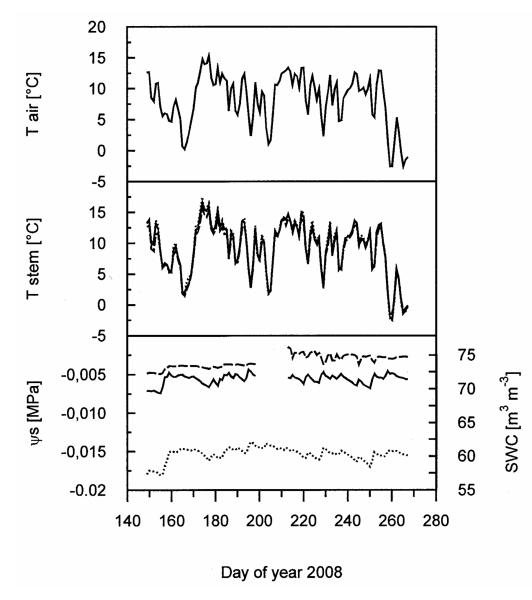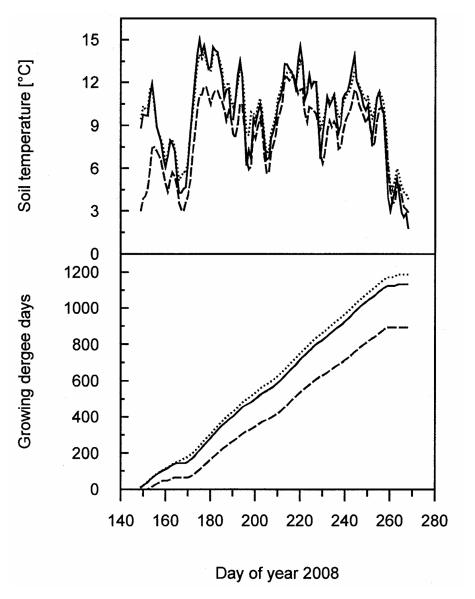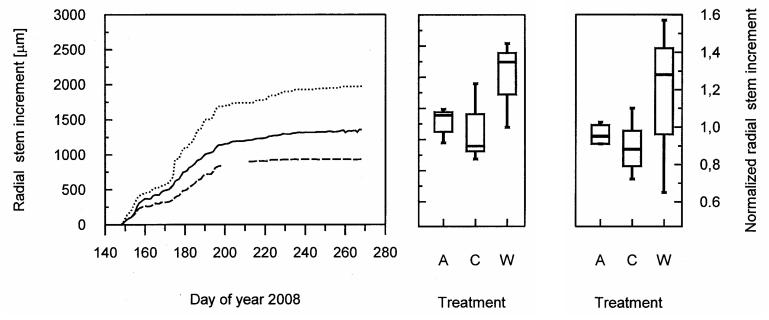Abstract
For assessing the impact of soil temperature on tree growth in remote areas such as the alpine timberline we introduce a new method for soil temperature manipulations. This new approach is based on roofing of the rooting zone and allows either soil cooling or soil warming without significantly influencing soil water availability and the above ground microclimate.
Keywords: soil temperature manipulation, root zone roofing, alpine timberline, Pinus cembra, stem increment, environmental change
Introduction
Low air and soil temperatures are major factors limiting tree growth at high altitude and latitude (Körner 1998) especially at the alpine timberline ecotone, which is regarded to be sensitive to climate change (Wieser et al. 2009). In-situ temperature manipulation is a common technique for assessing potential effects of warmer air and soil temperatures in boreal and alpine forest ecosystems and includes heating cables (Strömgren and Linder 2002), as well as open-top chambers (Danby and Hik 2007). Although artificial soil warming accomplished with heating cables provides a high degree of control over soil temperature over larger areas this technique can not be used in remote areas due to its high energy requirements. Open-top chambers techniques by contrast significantly alter the above ground microenvironment (most notably wind speed and moisture of the air), and thus also the physiological behaviour of the foliage.
As soil temperature also influences above ground metabolism and growth of timberline associated conifers (Havranek 1972) soil roofing is a potential alternative to investigate the effect of soil temperature on stem growth. Our objective was to test how a slight decrease or increase in soil temperature at the krummholz zone of the Central Austrian Alps will result in a difference in stem radius increment of Pinus cembra in order to predict the response of vegetation to a changing climate.
Material and Methods
The study was carried out on approximately 20-year-old stunted isolated Pinus cembra trees (0.5 - 0.8 m in height; projected crown 0.2-0.3 m2) growing in a haplic podzol on a south west slope (inclination 15-20°) in the krummholz belt (2180 m a.s.l.) on Mt. Patscherkofel south of Innsbruck, Austria (47°12′N, 11°27′E). The field site is characterized by a cool subalpine climate with low soil temperatures, the possibility of frost in all the months, a continuous snow cover from October till May, and by warm southerly winds (Föhn) with maxima up to 47 m s−1.
Soil temperature manipulation was accomplished by roofing of the root zone. The roofs had to allow for the possibility to manipulate soil temperature, to withstand high wind velocities, and not significantly influencing the above ground microclimate as well as soil water availability. Roofs (1.5 × 1.5 m) were built underneath the canopy 10 cm above ground around the stem of selected study trees. They consisted of frames anchored into the soil which were covered either with 3 cm thick Styrofoam (ROOFMATE SL-A) or 1 cm thick transparent Perspex plates to achieve soil cooling and warming, respectively. The roofs were perforated (10 × 10 cm grid) in order to allow precipitation falling onto the roofs to penetrate into the soil and thus allowing “real time watering” comparable to unroofed ambient conditions. After testing the roofs design in 2007 three roofs each were set up immediately after snow melt in spring 2008 in order to achieve either soil cooling (C) or soil warming (W) throughout the entire growing season (May 28 until Sept 25). Four additional trees in the vicinity served as untreated controls (A).
In order to quantify the roof's performance soil temperature (10TCRT, Campbell, Scientific, Shepshed; UK) and soil water potential (EQ3 Equitensiometer, Liu, Dachau, Germany) in 10 cm soil depth were measured continuously under one C, W, and A tree, respectively. Air temperature, relative humidity (HMP45C, Vaisala, Helsinki, Finland), solar radiation (SP-Lite, Campbell Scientific, Shepshed, UK), wind velocity (A100R, Campbell Scientific, Shepshed; UK) and precipitation (AGR100, Campbell Scientific, Shepshed; UK) were monitored 2 m above ground.
Stem temperature and radial stem increment of all the study trees were monitored on the north side of the stem 15 cm above ground by type-T thermocouples and custom made point dendrometers (Loris 1981), respectively. The dendrometers had an accuracy of 2 μm and consisted of an electronic displacement-sensor (linear motion potentiometer, MM10 Megatron, Putzbrunn/Munich, Germany) which was anchored on the stem with a stainless steel rod. At the end of the experiment we extracted core samples from all the study trees with an increment borer at the position of the dendrometers.
All the climatic, stem temperature, and dendrometer data were recorded with a Campbell CR10X data logger equipped with an AM416 multiplexer (Campbell Scientific, Shepshed; UK) programmed to record 30-minute averages of measurements taken every minute. In order to account for the inherent variability in growth among individuals not attributable to experimental factors radial stem increment was also normalized to the mean radial stem increment obtained in the two years before soil temperature manipulation treatment commenced. We used growing degree-days (GDD) with a threshold of 5 °C to represent the heat accumulation of the rooting zone throughout the growing season. The Mann-Whitney U-test using the exact probabilities for small sample sizes was used to test for treatment effects on radial stem increment stem and statistical significance was accepted at P < 0 (Bortz et al. 2000).
Results and Discussion
The seasonal parameters of environmental parameters were representative for the climatic conditions at the study site. Mean average air temperature was 8.1°C and varied between 15.3°C and −2.6°C (Fig. 1). Stem temperatures generally followed the seasonal trend in air temperature (Fig. 1) and averaged 9.1, 8.8 and 9.2°C in A, C and W trees, respectively. Due to frequent and ample precipitation during the study period (590 mm) daily mean soil water potential under A, C, and W trees varied between −0.001 and −0.018 MPa (Fig. 1). The observed differences in daily mean soil water potential among the three treatments however, were the within the normal variation observed at the study site (Guggenberger 1980). Even under the roofs of W trees soil water potential and volumetric soul water content remained always above −0.02 MPa and 55 m3 m−3, respectively, indicating our roofing system did not trigger any shortage in soil water availability.
Fig. 1.
Time course of daily mean air temperature (T air), stem temperature (T stem), soil water potential (Ψs), and volumetric soil water content (SWC) in 10 cm soil depth of trees grown under ambient soil temperature conditions (solid line), and of trees exposed to either experimentally soil cooling (hatched lines) or soil warming (dotted lines) from May 28 to September 25 2008.
Daily mean soil temperature in 10 cm depth under A trees averaged 9.7°C and varied between 15.0°C and 2.6°C (Fig. 2). Throughout the growing season the roofs maintained a mean daily soil temperature difference of −1.5°C and + 0.4°C under C and W trees, respectively (Fig. 2). Roofing however, significantly diminished the temperature amplitude. Absolute maximum and minimum soil temperatures obtained throughout the study period were 13.0 and 2.3°C and 16.9 and 3.5°C under C and W trees, respectively as compared to 19.0 and 1.0°C under unroofed controls. Nevertheless, soil warming had the highest GDD sum (1187), followed by controls (1132), and soil cooling (892) (Fig. 2).
Fig. 2.
Time course of daily mean soil temperature and heat accumulation in 10 cm soil depth under tree crowns grown under ambient soil temperature conditions (solid line), and under crowns of trees exposed to either experimentally soil cooling (hatched lines) or soil warming (dotted lines) from May 28 to September 25 2008.
The real test of our roofing system however, was the tree's response to our simulation. In general, radial stem increment tended to increase with the mean temperature and thermal heat accumulation in the soil (Fig. 2), and was lowest in C trees and highest in W trees (Fig. 3). Between treatments differences in absolute and normalized radial stem increment obtained at the end of the experiment however, were not statistically significant as only two trees per treatment responded to soil cooling or warming with a decrease and an increase in radial stem growth, while the opposite trend was observed in one C and W tree, respectively (Fig. 3).
Fig. 3.
Seasonal median radial stem increment (left) of trees grown under ambient soil temperature conditions (solid line), and of trees exposed to either experimentally soil cooling (hatched lines) or soil warming (dotted lines) from May 28 to September 25 2008, and median absolute (middle) and normalized (right) radial stem increment grown under ambient soil temperature (A) and exposed to either soil cooling (C) or soil warming (W).
Such observed difference in growth patterns with respect to soil cooling or warming may be attributed to the fact that tree growth in the timberline ecotone is restricted by both, low soil temperatures and low nutrient availability (Tranquillini 1979; Steinbjörnsson et al. 1992). Although a higher soil temperature forces the rate of soil nutrient mineralisation (Rustad et al. 2001), there is evidence that an increased growth rate can be achieved by either high soil temperature in combination with low nutrient availability or by low soil temperature in combination with high nutrient availability (Weih and Karlsson 2001; Strömgren and Linder 2002). Thus, varying nutrient contents with respect microtopography (Anschlag et al. 2008) may help explain observed differences in growth patterns within C and W trees. However, this was not investigated. In addition, the lack of a significant cooling or warming effect on radial stem increment in Pinus cembra after one year of temperature manipulation might also be explained by the fact that growth in any year is also predetermined during bud formation in the previous year (Tranquillini 1979; Körner 1998).
Based on our pilot study, we conclude that in contrast to artificial soil heating by cables and open-top-chambers which modify the above ground microenvironment the roofing approach offers an inexpensive, spatially and temporally way for estimating the effects of soil temperature on tree growth in remote areas such as the alpine timberline. Obtained results however, indicate that a long term monitoring with more replicates per treatment is necessary in order to obtain clear response patterns with respect to soil temperature manipulations and nutrient availability. Such data may also help quantifying the response of the timberline ecotone to predicted environmental changes.
Acknowledgements
This work was supported by the Austrian Science Fund: Project No. FWF P18819-B03 “Temperature dependence of Pinus cembra (L.) stem growth and respiration along an altitudinal transect”
References
- Anschlag K, Broll G, Holtmeier F-K. Mountain birch seedlings in the treeline ecotone, subarctic Finland: Variation in above- and below-ground growth depending on microtopography. Arct Antarctic Alp Res. 2008;40:609–616. [Google Scholar]
- Bortz J, Lienert GA, Boehnke K. Verteilungsfreie Methoden in der Biostatistik. Springer; Berlin: 2000. [Google Scholar]
- Danby RK, Hik DS. Response of white spruce (Pinus glauca) to experimental warming at a subarctic alpine treeline. Glob Change Biol. 2007;13:437–451. [Google Scholar]
- Guggengerger H. Untersuchungen zum Wasserhaushalt der alpine Zwergstrauchheide Patscherkofel. Innsbruck University; 1980. Ph.D. thesis. [Google Scholar]
- Havranek WM. Über die Bedeutung der Bodentemperatur für die Photoynthese und die Transpiration junger Forstpflanzen und die Stoffproduktion an der Waldgrenze. Angew Bot. 1972;46:101–116. [Google Scholar]
- Körner C. A re-assessment of high elevation treeline positions and their explanation. Oecologia. 1998;115:445–459. doi: 10.1007/s004420050540. [DOI] [PubMed] [Google Scholar]
- Loris K. Dickenwachstum von Zirbe, Fichte und Lärche an der alpine Waldgrenze/Patscherkofel. Ergebnisse der Dendrometermessungen 1976/79. Mitt Forstl Bundesversuchsanstalt Wien. 1981;142/II:414–441. [Google Scholar]
- Rustad LE, Campbell JL, Marion GM, Norby RJ, Mitchell MJ, Hartley AE, Cornelissen JHC, Gurevitch J, GCTE-NEWS A meta-analysis of the response of soil respiration, net nitrogen mineralization, and aboveground plant growth to experimental ecosystem warming. Oecologia. 2001;126:543–562. doi: 10.1007/s004420000544. [DOI] [PubMed] [Google Scholar]
- Steinbjörnsson B, Nordell O, Kauhanen H. Nutrient relations of mountain birch growth at and below the elevational tree-line in Swedish Lapland. Funct Ecol. 1992;6:213–220. [Google Scholar]
- Strömgren K, Linder S. Effect of nutrition and soil warming on stemwood production in a boreal Norway spruce stands. Glob Change Biol. 2002;8:1195–1204. [Google Scholar]
- Tranquillini W. Physiological ecology of the alpine timberline. Tree existence at high altitudes with special reference to the European Alps. Springer; Berlin: 1979. (Ecological Studies, vol 31). Heidelberg, New York. [Google Scholar]
- Weih M, Kartlsson PS. Growth response of Mountain birch to air and soil temperature: is increasing leaf-nitrogen content an acclimation to lower temperature? New Phytol. 2001;150:147–155. [Google Scholar]
- Wieser G, Matyssek R, Luzian R, Zwerger P, Pindur P, Oberhuber W, Gruber a. Effects of atmospheric and climate change at the timberline of the Central European Alps. Ann For Sci. 2009 doi: 10.1051/forest/2009023. in press. [DOI] [PMC free article] [PubMed] [Google Scholar]





